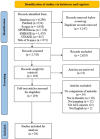Changes in Lower Limb Biomechanics Across Various Stages of Maturation and Implications for ACL Injury Risk in Female Athletes: a Systematic Review
- PMID: 38671176
- PMCID: PMC11257789
- DOI: 10.1007/s40279-024-02022-3
Changes in Lower Limb Biomechanics Across Various Stages of Maturation and Implications for ACL Injury Risk in Female Athletes: a Systematic Review
Abstract
Background: Female athletes are four to six times more likely to sustain an anterior cruciate ligament (ACL) injury than male athletes. Jump-landing biomechanics are influenced by maturation, with post-pubertal female athletes at a heightened risk of ACL injuries.
Objective: The aim of our systematic review was to identify and summarise the current evidence regarding the changes in kinematic and kinetic risk factors associated with ACL injuries during jump-landing tasks in female athletes at various stages of maturity.
Methods: A systematic search was conducted in PubMed, CINAHL, Web of Science, SPORTDiscus, EMBASE and Scopus. Articles were included if they: (1) conducted the research on uninjured female athletes with no restriction on playing level/experience; (2) provided information regarding the stage of the maturity and the scale used for estimating the maturity status of the participants; and (3) reported a biomechanical risk factor associated with ACL injuries during jump-landing tasks across at least two different maturity groups (e.g. pre-pubertal vs post-pubertal).
Results: Sixteen articles involving 2323 female athletes were included in our review. A total of 12 kinematic and 8 kinetic variables were identified across these studies. Of the 12 kinematic variables reported in our review, we found strong evidence for higher peak knee abduction angle in post-pubertal female individuals compared with pre-pubertal girls (p < 0.05). With regard to the 8 kinetic variables, we found strong evidence for lower relative peak vertical ground reaction force, higher external knee abduction moment and internal rotation moment in post-pubertal compared with pre-pubertal athletes. The strength of evidence for the remaining kinematic and kinetic variables ranged from conflicting to moderate and, in some instances, could not be determined.
Conclusions: Our study provides an overview of the changes in biomechanical risk factors in female athletes during jump-landing tasks at various stages of maturity. We found moderate-to-limited evidence for most kinematic and kinetic variables, highlighting the need for further research.
© 2024. The Author(s).
Conflict of interest statement
Gregory D. Myer consults with commercial entities to support commercialisation strategies and applications to the US Food and Drug Administration but has no direct financial interest in the commercialisation of the products. Gregory D. Myer’s institution receives current and ongoing grant funding from National Institutes of Health/NIAMS Grants U01AR067997, R01 AR070474, R01AR055563, R01AR076153, R01 AR077248, R61AT012421, the Department of Defense W81XWH22C0062 and Arthritis Foundation OACTN. Gregory D. Myer has received industry sponsored research funding to his institutions related to injury prevention and sport performance and has current ongoing funding from Arthrex, Inc. to evaluate ACL surgical treatment optimisation strategies. Gregory D. Myer receives author royalties from Human Kinetics and Wolters Kluwer. Gregory D. Myer is an inventor of biofeedback technologies (Patent No.: US11350854B2, Augmented and Virtual reality for Sport Performance and Injury Prevention Application, Approval Date: 06/07/2022, Software Copyrighted) designed to enhance rehabilitation and prevent injuries that receives licensing royalties. Akhilesh Kumar Ramachandran, Jason S. Pedley, Sylvia Moeskops, Jon L. Oliver and Rhodri S. Lloyd have no conflicts of interest that are directly relevant to the content of this article.
Figures



Similar articles
-
Influence of Neuromuscular Training Interventions on Jump-Landing Biomechanics and Implications for ACL Injuries in Youth Females: A Systematic Review and Meta-analysis.Sports Med. 2025 May;55(5):1265-1292. doi: 10.1007/s40279-025-02190-w. Epub 2025 Apr 17. Sports Med. 2025. PMID: 40246764 Free PMC article.
-
What is normal? Female lower limb kinematic profiles during athletic tasks used to examine anterior cruciate ligament injury risk: a systematic review.Sports Med. 2014 Jun;44(6):815-32. doi: 10.1007/s40279-014-0168-8. Sports Med. 2014. PMID: 24682949
-
Trunk and Lower Extremity Biomechanics in Female Athletes With and Without a Concussion History.J Athl Train. 2024 Jul 1;59(7):751-761. doi: 10.4085/1062-6050-0259.23. J Athl Train. 2024. PMID: 37681680 Free PMC article.
-
A Systematic Evaluation of Field-Based Screening Methods for the Assessment of Anterior Cruciate Ligament (ACL) Injury Risk.Sports Med. 2016 May;46(5):715-35. doi: 10.1007/s40279-015-0443-3. Sports Med. 2016. PMID: 26626070
-
Lower Limb Biomechanics During Single-Leg Landings Following Anterior Cruciate Ligament Reconstruction: A Systematic Review and Meta-Analysis.Sports Med. 2018 Sep;48(9):2103-2126. doi: 10.1007/s40279-018-0942-0. Sports Med. 2018. PMID: 29949109
Cited by
-
The Effect of Sensor Feature Inputs on Joint Angle Prediction across Simple Movements.Sensors (Basel). 2024 Jun 5;24(11):3657. doi: 10.3390/s24113657. Sensors (Basel). 2024. PMID: 38894447 Free PMC article.
-
Exploring Lower Limb Biomechanical Differences in Competitive Aerobics Athletes of Different Ability Levels During Rotational Jump Landings.Bioengineering (Basel). 2025 Feb 21;12(3):220. doi: 10.3390/bioengineering12030220. Bioengineering (Basel). 2025. PMID: 40150685 Free PMC article.
-
Differences in Kinematic and Muscle Activity Between ACL Injury Risk and Healthy Players in Female Football: Influence of Change of Direction Amplitude in a Cross-Sectional Case-Control Study.Medicina (Kaunas). 2025 Jul 11;61(7):1259. doi: 10.3390/medicina61071259. Medicina (Kaunas). 2025. PMID: 40731888 Free PMC article.
-
Effects of different peripheral fatigue protocol on lower limb biomechanical changes during landing and its impact on the risk of anterior cruciate ligament injury: a systematic review.Front Bioeng Biotechnol. 2025 Jun 3;13:1587573. doi: 10.3389/fbioe.2025.1587573. eCollection 2025. Front Bioeng Biotechnol. 2025. PMID: 40567252 Free PMC article.
-
The effect of pilates training on knee functional tests in youth female volleyball player.BMC Sports Sci Med Rehabil. 2025 Jul 18;17(1):206. doi: 10.1186/s13102-025-01258-4. BMC Sports Sci Med Rehabil. 2025. PMID: 40682178 Free PMC article.
References
-
- Longo UG, Salvatore G, Ruzzini L, Risi Ambrogioni L, de Girolamo L, Vigano M, et al. Trends of anterior cruciate ligament reconstruction in children and young adolescents in Italy show a constant increase in the last 15 years. Knee Surg Sports Traumatol Arthrosc. 2021;29(6):1728–1733. doi: 10.1007/s00167-020-06203-1. - DOI - PubMed
Publication types
MeSH terms
Grants and funding
LinkOut - more resources
Full Text Sources

